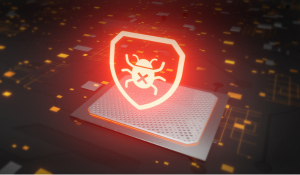Indicators of Attack: Proactive Defense in Cybersecurity
In the dynamic world of IT security, a reactive approach is no longer sufficient. Relying solely on cleaning up after a breach leaves your...
6 min read
 DriveLock
Aug 13, 2025 10:58:55 AM
DriveLock
Aug 13, 2025 10:58:55 AM

Cyber threats are evolving rapidly. For organizations in healthcare, manufacturing and critical infrastructure, it is crucial to remain vigilant. Recognizing the first signs of a cyberattack can make the difference between an insignificant incident and a devastating data breach. This is exactly where Indicators of Compromise (IoCs) come in.
| CONTENT |
They are the crucial pieces of the puzzle that help us identify and fend off digital attacks at an early stage. Without a deep understanding and consistent application of indicators of compromise, even the most robust security systems are vulnerable to undetected and malicious intrusions.
Indicators of Compromise, or IoCs for short, are digital artifacts or forensic data that indicate a potential security breach in a network or system. They are like the traces left by an intruder at a crime scene. Detecting and analyzing these traces enables security teams to detect, isolate and remediate attacks early before major damage is done.
IoCs can take a variety of forms, from unusual network traffic to suspicious file hashes to anomalies in system logs. They are the evidence that an attacker may have gained access to your system or is attempting to do so.
The terms Indicators of Compromise (IoCs) and Indicators of Attack (IoAs) are often mistakenly used interchangeably. However, there is a crucial difference that is extremely important for effective cyber defense and clearly separates the two phases of attack detection.
Indicators of Compromise (IoCs): Indicators of compromise (IoCs) are the digital traces left behind by an attacker after penetrating a system or during an ongoing attack. They are reactive in nature and are used to identify whether a compromise has already occurred or is active. They can be thought of as forensic evidence: a suspicious IP address siphoning off unexpectedly high amounts of data, the hash value of a malicious file found on the network, or an unusual change to critical system files. Detecting IoCs is critical to limiting the damage of an attack and initiating a rapid response.
Indicators of Attack (IoAs): Indicators of Attack (IoAs), on the other hand, are signs that an attacker is actively trying to penetrate a system or perform a specific action even before a compromise has occurred. IoAs are proactive in nature and focus on the attacker's behaviors and tactics, techniques and procedures (TTPs). Examples include repeated failed login attempts to a user account (brute force attack), port scanning to identify vulnerabilities or attempting to gain administrator privileges. IoAs enable security teams to detect and stop attacks in their early stages before they can cause damage.
Put simply, while IoAs are the warning signs of an impending break-in, such as someone trying to pick the door locks, IoCs are the evidence that someone has already been inside or is currently inside, such as open windows or stolen items. A truly robust security strategy combines preventative monitoring of IoAs with detective analysis of IoCs to both deter attacks early and quickly detect and remediate existing compromises.
The way indicators of compromise work is based on the assumption that every cyberattack leaves traces. These traces can be identified by security tools and human analysts. The process is typically as follows:
Collection of data: security systems such as firewalls, intrusion detection/prevention systems (IDS/IPS), security information and event management (SIEM) systems and endpoint detection and response (EDR) solutions continuously collect an enormous amount of data - network logs, system logs, file activity, login attempts and more.
Analysis and correlation: This collected data is analyzed and correlated to identify patterns that indicate a deviation from normal behavior. This is also where threat intelligence comes into play, containing known indicators of compromise from previous attacks.
Identification of anomalies: Deviations that correspond to known IoCs or are unusual are flagged as potential security events.
Alerting and response: When an IoC is detected, security teams are alerted, who then initiate a forensic investigation to determine the nature and extent of the threat and take appropriate countermeasures.
By continuously monitoring for indicators of compromise, organizations can quickly respond to security incidents, minimize the damage and prevent future attacks.
To build a robust defense against cyberattacks, it is essential to know and be able to interpret the most common types of Indicators of Compromise (IoCs). These digital fingerprints provide concrete evidence of a past or ongoing compromise and allow for quick and targeted intervention. Here are the most important indicators of compromise that you should identify in your systems:
Malicious IP addresses and domains: cybercriminals use specific IP addresses or domain names to host their command-and-control (C2) servers or deliver malicious payloads. An IoC is when your network has unusual traffic to or from such known malicious addresses. This often indicates communication with an external attacker who may be sending commands to or receiving data from compromised systems. Up-to-date threat data feeds are essential here to keep these blacklists up to date.
Malware file hashes: Each file has a unique hash value, which is effectively its digital fingerprint. If a security system checks the hash of a file found on your system against a database of known malware hashes and finds a match, this is an indisputable indicator of compromise. This means that a known malicious software exists or has been executed on your system. This IoC allows for precise identification and quarantine of the threat.
Unusual outbound network traffic: At the heart of many cyberattacks is data exfiltration, the unauthorized extraction of data from your network. If your monitoring system detects unusually large amounts of data flowing to external, atypical destinations, this is a strong warning signal. The outflow of data via atypical ports or protocols can also indicate a compromise. This requires an immediate investigation to determine the origin and destination of the data outflow.
Anomalies in login attempts: Attackers often attempt to gain access to systems by stealing or guessing login credentials. Multiple failed login attempts from a single account or IP address within a short period of time may indicate a brute force attack. Logins from unusual geographical locations, at atypical times (e.g. in the middle of the night from a distant country) or from previously unknown devices are also critical IoCs that require immediate attention.
Changes to system files and configurations: Attackers often manipulate system files, registry keys or configurations after a successful compromise to disguise their presence, gain persistence or prepare for further attacks. Finding unexplained changes to critical system files, libraries or the system registry is a clear IoC and requires detailed forensic analysis to understand the nature of the tampering.
Unusual file names or locations: Malware often tries to disguise itself as legitimate system processes or harmless documents. If you find executable files in atypical locations such as user profiles, temporary directories or in the recycle bin, this is a strong IoC. File names that are seemingly harmless but do not match the context (e.g. "rechnung.exe" in the Windows system directory) should also make you suspicious.
Compromised user accounts: A critical indicator of compromise is finding that a user account that is normally inactive is suddenly showing activity, or that a standard user account has unexpectedly been given elevated privileges. This often indicates that an attacker has compromised the account and is misusing it for their own purposes. Checking access logs and authorizations is essential here.
Suspicious DNS requests: The Domain Name System (DNS) is often used by attackers to establish communication with their C2 servers. Unusual or repeated DNS requests to domains unknown to you or classified as suspicious may indicate such communication and are an important IoC. This requires close monitoring of DNS traffic on your network.
Web Shells: A web shell is a malicious script or application that an attacker places on a web server to enable remote connection and command execution. Finding a web shell on one of your web servers is a clear IoC and signals that the attacker has created a backdoor that gives them extensive control over the server. This requires immediate cleanup and a full investigation of the compromise.
Given the increasing sophistication of cyberattacks, rapid detection and response to Indicators of Compromise (IoCs) is critical. For IT specialists in healthcare, manufacturing and critical infrastructure, this knowledge is not only an advantage, but an indispensable pillar of corporate security. Proactively searching for these digital traces and the targeted use of advanced security technologies enables us to effectively protect our networks and data.
By taking the early warning signs seriously and acting consistently, we can strengthen the resilience of our systems and protect the valuable information entrusted to us. Continuously dealing with the latest IoCs and adapting our defense mechanisms is not an option, but a necessity. This is the only way we can counter the constantly evolving threats and ensure the integrity of our digital infrastructures.

In the dynamic world of IT security, a reactive approach is no longer sufficient. Relying solely on cleaning up after a breach leaves your...

An Intrusion Detection System (IDS) emerges as a stalwart defender, standing vigilant to detect and thwart potential threats within computer networks...

The threat situation in cyberspace is constantly evolving. New attack vectors, techniques and vulnerabilities emerge every day. It is therefore...